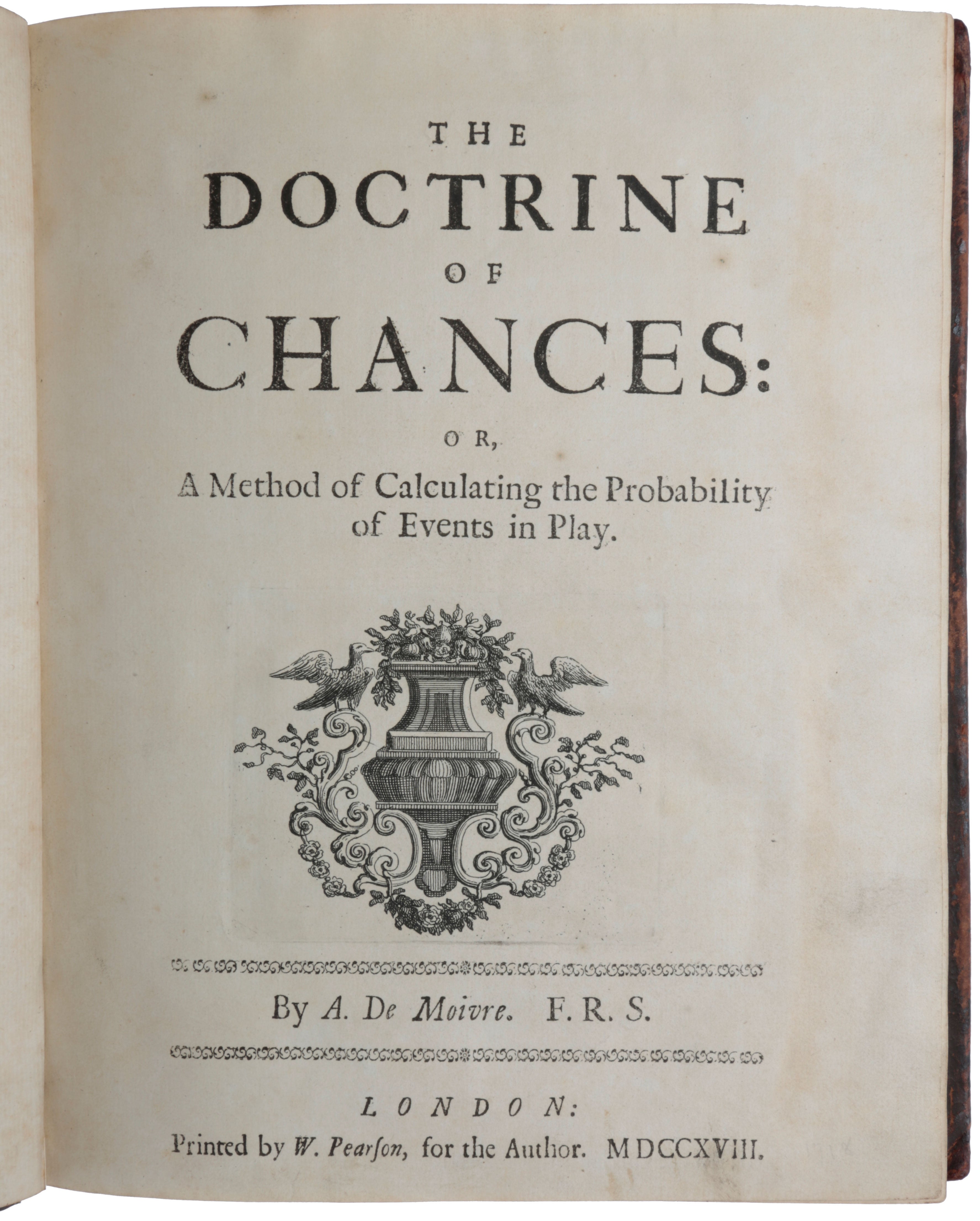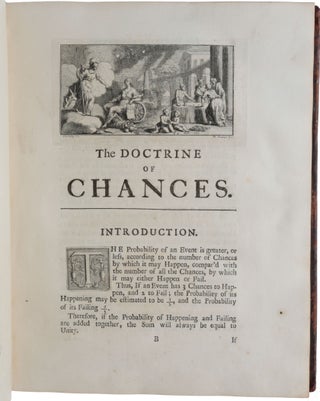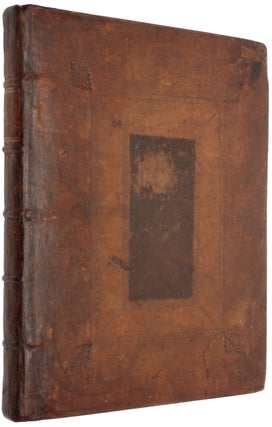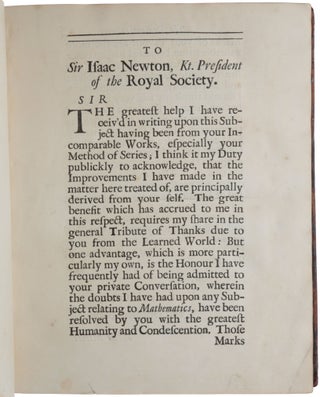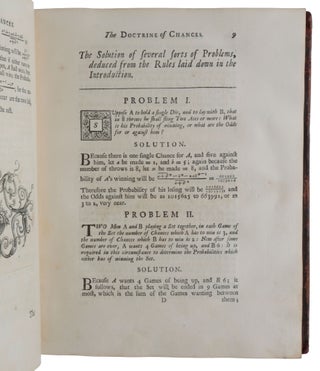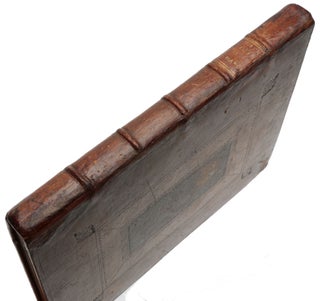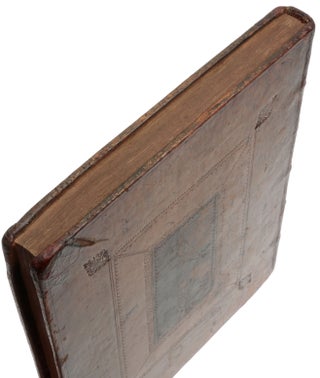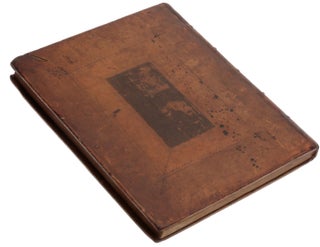The Doctrine of Chances: or, A Method of Calculating the Probability of Events in Play.
London: W[illiam]. Pearson for the Author, 1718. First edition of this classic on the theory of probability, the first original work on the subject in English. “De Moivre’s book on chances is considered the foundation for the field of probability and statistics” (Tomash). “De Moivre’s masterpiece is The Doctrine of Chances” (DSB). “His work on the theory of probability surpasses anything done by any other mathematician except P. S. Laplace. His principal contributions are his investigations respecting the Duration of Play, his Theory of Recurring Series, and his extension of the value of Daniel Bernoulli’s theorem by the aid of Stirling’s theorem” (Cajori, A History of Mathematics, p. 230). “He was among the intimate friends of Newton, to whom this book is dedicated. It is the second book devoted entirely to the theory of probability and a classic on the subject” (Babson 181). De Moivre’s interest in probability was raised by Pierre-Rémond de Montmort’s Essay d’analyse sur les jeux de hazard (1708), the first separately-published work on probability. “The [Doctrine] is in part the result of a competition between De Moivre on the one hand and Montmort together with Nikolaus Bernoulli on the other. De Moivre claimed that his representation of the solutions of the then current problems tended to be more general than those of Montmort, which Montmort resented very much. This situation led to some arguments between the two men, which finally were resolved by Montmort’s premature death in 1719 … De Moivre had developed algebraic and analytical tools for the theory of probability like a ‘new algebra’ for the solution of the problem of coincidences which somewhat foreshadowed Boolean algebra, and also the method of generating functions or the theory of recurrent series for the solution of difference equations. Differently from Montmort, De Moivre offered in [Doctrine] an introduction that contains the main concepts like probability, conditional probability, expectation, dependent and independent events, the multiplication rule, and the binomial distribution” (Schneider, p. 106). Provenance: Charles Meynell (early engraved bookplate). The modern theory of probability is generally agreed to have begun with the correspondence between Pierre de Fermat and Blaise Pascal in 1654 on the solution of the ‘Problem of points’. Pascal included his solution as the third section of the second part of his 36-page Traité du triangle arithmétique (1665), which was essentially a treatise on pure mathematics. “Huygens heard about Pascal’s and Fermat’s ideas [on games of chance] but had to work out the details for himself. His treatise De ratiociniis in ludo aleae … essentially followed Pascal’s method of expectation. … At the end of his treatise, Huygens listed five problems about fair odds in games of chance, some of which had already been solved by Pascal and Fermat. These problems, together with similar questions inspired by other card and dice games popular at the time, set an agenda for research that continued for nearly a century. The most important landmarks of this work are [Jakob] Bernoulli’s Ars conjectandi (1713), Montmort’s Essay d'analyse sur les jeux de hazard (editions in 1708 and 1711 [i.e., 1713]) and De Moivre’s Doctrine of Chances (editions in 1718, 1738, and 1756). These authors investigated many of the problems still studied under the heading of discrete probability, including gamblers ruin, duration of play, handicaps, coincidences and runs. In order to solve these problems, they improved Pascal and Fermat’s combinatorial reasoning, summed infinite series, developed the method of inclusion and exclusion, and developed methods for solving the linear difference equations that arise in using Pascal’s method of expectations.” (Glenn Schafer in Companion Encyclopedia of the History and Philosophy of the Mathematical Sciences (1994), Grattan-Guiness (ed.), p. 1296). “De Moivre’s earliest book on probability, the first edition of the Doctrine of Chances, was an expansion of a long (fifty-two pages) memoir he had published in Latin in the Philosophical Transactions of the Royal Society in 1711 under the title ‘De mensura sortis’ (literally, ‘On the measurement of lots’). De Moivre tells us that in 1711 he had read only Huygens’ 1657 tract De Ratiociniis in Ludo Aleae and an anonymous English 1692 tract based on Huygens’ work (now known to have been written by John Arbuthnot). By 1718 he had encountered both Montmort’s Essay d’analyse sur les jeux de hazard (2nd ed., 1713) and Bernoulli’s Ars Conjectandi (1713), although the latter had no pronounced effect on De Moivre at that early date” (Stigler, p. 71). The Doctrine consists of an introduction with definitions and elementary theorems, followed by a series of numbered problems. “De Moivre begins with the classical measure of probability, ‘a fraction whereof the numerator be the number of chances whereby an event may happen, and the denominator the number of all the chances whereby it may either happen or fail’. He gives the summation rule for probabilities of disjunct events explicitly only for the case of the happening and the not happening of an event. Expectation is still on the level of Huygens defined as the product of an expected sum of money and the probability of obtaining it, the expectation of several sums is determined by the sum of the expectations of the singular sums. He defines independent and dependent events and gives the multiplication rule for both. But whereas today the criterion for independence of two events is the validity of the multiplication rule in the [Doctrine], the multiplication rule follows from the independence of the events, which seems to be a self-evident concept for De Moivre … “With these tools ‘those who are acquainted with Arithmetical Operations’ (as De Moivre remarked in the preface) could tackle many problems, in part already well known but which he gradually generalized. Because the majority of the solved problems depends on rules ‘being entirely owing to Algebra’ and to combinatorics, De Moivre tried to convince those readers who had not studied algebra yet to ‘take the small Pains of being acquainted with the bare Notation of Algebra, which might be done in the hundredth part of the Time that is spent in learning to write Short-hand’. Remarks of this kind are typical of the private teacher of mathematics De Moivre, who was accustomed to ask his clients before he began with his instructions about their mathematical knowledge” (Schneider, pp. 107-9). Following the introduction are 53 numbered problems: I-XIV are various problems solvable with the rules contained in the introduction including problems dealing with the games of Bassette (XIII) and Pharaon (XIV); XV-XXXII are problems solvable by combinatorial methods, including some dealing with lotteries (XXI and XXII), and of Pharaon (XXIII); XXXIII-XLVI are concerned with the problem of the duration of play, or the ruin problem; and XLVII-LIII are further problems solvable by combinatorial methods, including Hazard (XLVII, LIII), Whisk (XLVIII), Raffling (XLIX) and Piquet (LI, LII). “Some problems, as already stated by Jakob Bernoulli (1654–1705) in his Ars conjectandi, can be solved more easily by the use of infinite series. As an illustration de Moivre offers the problem to determine the amounts each of two players A and B has to stake under the condition that the player who throws the first time an Ace with an ordinary die wins the stake and that A has the first throw. He considers it as reasonable that A should pay 1/6 of the total stake in order to have the first throw, B should pay 1/6 of the rest which is 1/6.5/6 for having the second throw, A should pay 1/6 of the remainder for having the third throw, etc. The part that A has to stake altogether is the sum of a geometrical series with 1/6 as the first term and the quotient 25/36, which is 6/11 of the total stake. Accordingly B’s share is 5/11 of the total stake. De Moivre claims that in most cases where the solution affords the application of infinite series the series are geometrical [in which each term is a fixed multiple of the preceding term]. The other kind of infinite series which relate to the problem of the duration of play are recurrent series the terms of which can be connected with the terms of geometrical series. Other problems depend on the summation of the terms of arithmetical series of higher orders and a ‘new sort of algebra’” (Schneider, pp. 109-110). Recurrent series – those in which each term of the series is related to a fixed number of preceding terms by a fixed (linear) relation – are needed in the solution of the problem of the duration of play. “It resulted from a generalization of the last problem that Huygens had posed to his readers at the end of his treatise De ratiociniis in ludo aleae (1656). The first to deal with the problem in the new form seems to be Montmort, and after him Nikolaus Bernoulli. De Moivre concerned himself with it at about the same time. His formulation of the problem in the [Doctrine] of 1718 is nearly the same as he used in the third edition (p. 191): ‘Two gamesters A and B whose proportion of skill is as a to b, each having a certain number of pieces, play together on condition that as often as A wins a game, B shall give him one piece; and that as often as B wins a game, A shall give him one piece; and that they cease not to play till such time as either one or the other has got all the pieces of his adversary: now let us suppose two spectators R and S concerning themselves about the ending of the play, the first of them laying that the play will be ended in a certain number of games which he assigns, the other laying to the contrary. To find the probability that S has of winning his wager’” (Schneider, p. 112). De Moivre gave a complete solution of the problem of duration of play in Doctrine, but he did not indicate how he had obtained the results, and this became a challenge to the next generation of probabilists, notably Laplace (see Hald, pp. 361 et seq). One of the most important devices introduced by De Moivre is that of a ‘generating function’, later developed extensively by Laplace. De Moivre introduces generating functions in his solution of Problem III. “It asks after the number of chances to throw a given number p + 1 of points with n dice, each of them of the same number f of faces. Here the word ‘dice’ or ‘die’ is used in the more general sense of, for example, a roulette wheel with f sectors” (Schneider, p. 110). De Moivre introduced a series whose coefficients are the chances sought, and was able to determine the sum of the series, from which the chances were easily found. Indeed, he formed the series f(r) = 1 + r + r2 + … + rf-1 = (1 – rf)/(1 – r) and noted that the number of chances required is equal to the coefficient of the term with exponent p + 1 – n in the expansion of f(r)n = (1 – rf)n.(1 – r)-n, an expansion which is easily obtained using the binomial theorem. “An early reaction to the book which surely accounts for the high estimation it was held at least in England is its exploitation by the Englishman Thomas Simpson, who in his Treatise on the nature and laws of chance (1740) just repeated the results achieved in the [Doctrine]. The fact that De Moivre had specialized in the theory of probability, for which he had prepared appropriate tools and to which he had contributed the solutions of the most interesting problems posed to him by his competitors and by his clients for some decades, made [Doctrine], especially the last edition of 1756, the most complete representation of the new field in the second half of the 18th century. “This was felt by the leading mathematicians of the next generation. In particular, J.L. Lagrange and Laplace had planned a French translation of the book which however was never realized. Their interest goes back to De Moivre’s solution of the problem of the duration of play by means of what he called ‘recurrent series’ and what amounts to the solution of a homogeneous linear difference equation with constant coefficients. In fact, the most effective analytical tool developed by Laplace for the calculus of probabilities, the theory of generating functions, is a consequence of his concern with recurrent series. Indeed, the most important results of the book reappear in Laplace’s probability theory in a new mathematical form and in a new philosophical context. This, more than anything else, confirms de Moivre’s status as a pioneer in the field and as a predecessor of Laplace” (Schneider, p. 119). At the top of page 1 of the text is an engraving which De Moivre himself had designed. It shows Minerva, on the left of the picture, pointing to a piece of paper with a circle on it; this alluded to his solution to the problem of the duration of play, the details of which he had withheld in the book. The piece of paper is held by Fortuna, the goddess of fortune. She is identified by the wheel of fortune behind her and the cornucopia at her feet. With Minerva standing at a dominant position over Fortuna, the interpretation is that De Moivre’s mathematical results dominate fickle fortune or fate. The paper under the cornucopia has some illegible writing on it. It may represent some previous work that has borne fruit, perhaps referring to Huygens’ original results in De ratiociniis. On the right of the picture four men stand around a table with dice and a dice box on it. The clean-shaven man is De Moivre; he is instructing the other men on the theory of probability. A similar engraving is found at the beginning of Montmort’s Essay, but there it is the God Mercury standing at the table watching a man and a woman play a game of dice. Thus De Moivre is taking a swipe at Montmort, expressing through the engraving that he does not have the effrontery to speak directly to the gods and instruct them. The middle part of the engraving has two additional swipes at Montmort. Two naked boys are sitting with a pair of dice at their feet. A short distance away are some discarded cards and further yet is a chessboard of size 4 x 6 squares rather than the standard 8 x 8 shown in Montmort’s engraving. One of the boys is reading a book, perhaps Doctrine of Chances, to the other explaining De Moivre’s newly discovered results in probability. The discarded chessboard, being incomplete, is an indication that the work in Montmort’s Essay is also incomplete. Abraham Moivre stemmed from a Protestant family. His father was a surgeon from Vitry-le-François in the Champagne. From the age of five to eleven he was educated by the Catholic Péres de la doctrine Chrètienne. Then he moved to the Protestant Academy at Sedan were he mainly studied Greek. After the latter was forced to close in 1681 for its profession of faith, Moivre continued his studies at Saumur between 1682 and 1684 before joining his parents who had meanwhile moved to Paris. At that time he had studied some books on elementary mathematics and the first six books of Euclid’s elements. He had even tried his hand at Huygens’ 1657 tract without mastering it completely. In Paris he was taught mathematics by Jacques Ozanam who had made a reputation from a series of books on practical mathematics and mathematical recreations. Ozanam made his living as a private teacher of mathematics. He had extended the usual teachings of the European reckoning masters and mathematical practitioners by what was considered fashionable mathematics in Paris. Ozanam enjoyed a moderate financial success due to the many students he attracted. It seems plausible that young Moivre took him as a model he wanted to follow when he had to support himself. After the revocation of the Edict of Nantes in 1685 the Protestant faith was no longer tolerated in France, and hundreds of thousands of Huguenots who had refused to convert to Catholicism emigrated to Protestant countries. Amongst them was Moivre who arrived in England in 1687. There he began his occupation as a tutor in mathematics. He also added a ‘De’ to his name, probably because he wanted to take advantage of the prestige of a (pretended) noble birth in France in dealing with his clients, many of whom were noblemen. An anecdote from this time which goes back to (De) Moivre himself tells that he cut out the pages of Newton’s Principia of 1687 and read them while waiting for his students or walking from one to the other – the main function of this anecdote was to demonstrate that De Moivre was amongst the first true and loyal Newtonians and that as such he deserved help and protection in order to gain a better position than that of a humble tutor of mathematics. In 1692 De Moivre met with Edmond Halley and shortly afterwards with Newton. Halley ensured the publication of De Moivre’s first paper on Newton’s doctrine of fluxions in the Philosophical Transactions for 1695 and saw to his election to the Royal Society in 1697. Newton’s influence concerning university positions in mathematics and natural philosophy persuaded De Moivre to engage in the solution of problems posed by the new infinitesimal calculus. In 1697 and 1698 he published the polynomial theorem, a generalization of Newton’s binomial theorem, together with application in the theory of series. In 1704 De Moivre began a correspondence with Johann Bernoulli, but Bernoulli’s letters showed De Moivre that he lacked the time and perhaps the mathematical power to compete with a mathematician of this calibre in the new field of analysis. De Moivre ceased his correspondence with Bernoulli after he was made a member of the Royal Society commission to adjudicate in the priority dispute between Newton and Leibniz over the invention of calculus – continuing the correspondence may have made him appear disloyal to the Newtonian cause. When the Lucasian chair in mathematics at Cambridge was given in 1711 on Newton’s recommendation to Nicholas Saunderson, De Moivre realized that this only option was to continue his occupation as a tutor and consultant in mathematical affairs in the world of the coffee houses where he met his clients; additional income he could draw from the publication of books and from translations. He therefore turned to the calculus of games of chance and probability theory which was of great interest for many of his students and where he had few competitors in England. Babson/Newton 181; ESTC T33065; Goldsmiths'-Kress 05509.2-1; Norman 1529; Tomash M114 (this copy). Bellhouse, Abraham de Moivre (see pp. 114-8 for a discussion of the engraved vignette). Hald, History of Probability and Statistics and their Applications before 1750, Chapter 22. Schneider, ‘Abraham de Moivre, The Doctrine of Chances (1718, 1738, 1756),’ Chapter 7 in Landmark Writings in Western Mathematics 1640-1940, Grattan-Guinness (ed.). Stigler, The History of Statistics, pp. 70-85.
Large 4to (251 x 200 mm), pp. [iv], xiv, 175, [1, blank]. Engraved vignette on title and engraved head- & tailpieces. Contemporary English panelled calf, spine with well-done restoration. Preserved in a black morocco-backed folding box, gilt lettering on spine.
Item #5803
Price: $17,500.00

